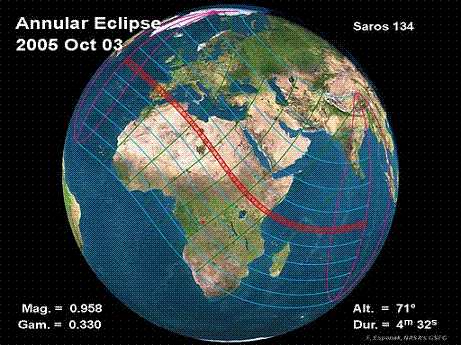
reminder. Today, Monday, Rosh Hashanah Eve, October 3, 2005, Israel will see a partial solar eclipse at a rate of about 50%. On the occasion of the eclipse, the Astronomical Club of Tel Aviv University and the Neena Astronomy Forum will hold a solar observation (with appropriate protective measures), accompanied by explanations about the solar eclipse and the sun. The observation will take place from 11:00 a.m. to 14:00 p.m. in Antin Square, in the square next to the main entrance to Tel Aviv University (next to the squid store).
A solar eclipse occurs when the Moon passes between an observer on Earth and the Sun. In such a situation, the moon may hide part or all of the sun from the viewer's eyes. A solar eclipse is a local phenomenon that occurs each time along narrow strips on the Earth's surface.
It could be expected that a solar eclipse (including a lunar eclipse, which occurs when the moon passes inside the earth's shadow), will occur once a month, but this is not the case, since the moon's orbit around the earth is inclined at an angle of about 5 degrees relative to the orbit of the earth around the sun Therefore, on average about two solar eclipses occur per year.
A very small part of the defects can be observed from Israel. Total solar eclipses are a spectacular natural phenomenon (much more so than partial eclipses even at a rate of 99%), and are considered one of the most beautiful natural wonders to watch. A total solar eclipse will be seen from Israel next time only in 2180!
And also in Jerusalem
The Hebrew University will mark the astronomical event in a special event open free of charge to children and adults. The event, which will take place from 11:30 a.m. to 14:00 p.m., will include lectures, observations of the eclipse and other activities intended mainly for children and young people. The open event will take place at Shochor Mada Youth Plaza, on the Edmond Y. Safra campus in Givat Ram.
Warning: Do not observe the sun without appropriate protective measures (see cautionary rules for observing the sun) - observing the sun without protective measures can cause irreversible eye damage and even blindness.
Annular defect
In any case, the eclipse that will be partially visible from Israel (see map) will not be full anywhere but annular. When the moon begins to cover the sun, the shadow of the eclipse will begin in the North Atlantic Ocean at 08:41 GMT (11:41 Israel time) in the North Atlantic Ocean. He will continue towards the southeast. It will cross the northern coast of Spain and Portugal (08:51 GMT), diagonally cross the Iberian Peninsula and arrive in Madrid (08:56). The annular phase will last 4 minutes and 11 seconds. An eclipse will be visible from the capital of Spain where 90 percent of the sun's face is hidden by the moon.
The island of Ibiza symbolizes the northern border where the shadow will cross the western Mediterranean. Algiers is also in the path of the shadow (09:05) and its residents will see an annular eclipse that will last three minutes and 15 seconds. The eclipse will continue towards the southeast and pass through southern Tunisia and central Libya, when
The shadow of the moon will return half a year later in the total eclipse of March 29, 2006. After a short passage in northern Chad, the shadow will pass over central Sudan at 10:31. The annular eclipse phase here will last 4 minutes and 31 seconds and the sun will be at an angle of 71 degrees above the desert. The path of the eclipse will continue along the border between Sudan and Ethiopia, entering northern Kenya (11:10). From there it will continue to Somalia (11:30) and finally disappear in the Indian Ocean, and disappear with local sunset (12:22 GMT).
An annular eclipse differs from a total eclipse because the moon appears too small to completely cover the sun. As a result the Moon is surrounded by a much brighter ring formed by the uncovered parts of the Sun's disk. The corona is not visible in an annular defect. Moreover, solar filters are required to observe all phases of the annular eclipse.
On solar eclipses in astrology
The Astronomical Club of Tel Aviv University
Astronomy expert - eclipses and transitions
A website detailing everything about the eclipse expected on October 3, 2005
https://www.hayadan.org.il/BuildaGate4/general2/data_card.php?Cat=~~~280149270~~~226&SiteName=hayadan
